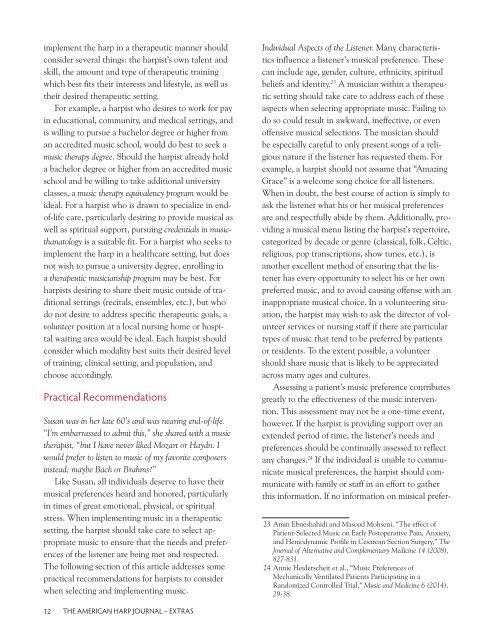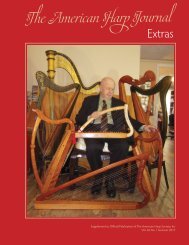The American Harp Journal - Extras - Summer 2018
Supplement to Vol. 26 No. 3 (Summer 2018) of The American Harp Journal
Supplement to Vol. 26 No. 3 (Summer 2018) of The American Harp Journal
Create successful ePaper yourself
Turn your PDF publications into a flip-book with our unique Google optimized e-Paper software.
implement the harp in a therapeutic manner should<br />
consider several things: the harpist’s own talent and<br />
skill, the amount and type of therapeutic training<br />
which best fits their interests and lifestyle, as well as<br />
their desired therapeutic setting.<br />
For example, a harpist who desires to work for pay<br />
in educational, community, and medical settings, and<br />
is willing to pursue a bachelor degree or higher from<br />
an accredited music school, would do best to seek a<br />
music therapy degree. Should the harpist already hold<br />
a bachelor degree or higher from an accredited music<br />
school and be willing to take additional university<br />
classes, a music therapy equivalency program would be<br />
ideal. For a harpist who is drawn to specialize in endof-life<br />
care, particularly desiring to provide musical as<br />
well as spiritual support, pursuing credentials in musicthanatology<br />
is a suitable fit. For a harpist who seeks to<br />
implement the harp in a healthcare setting, but does<br />
not wish to pursue a university degree, enrolling in<br />
a therapeutic musicianship program may be best. For<br />
harpists desiring to share their music outside of traditional<br />
settings (recitals, ensembles, etc.), but who<br />
do not desire to address specific therapeutic goals, a<br />
volunteer position at a local nursing home or hospital<br />
waiting area would be ideal. Each harpist should<br />
consider which modality best suits their desired level<br />
of training, clinical setting, and population, and<br />
choose accordingly.<br />
Practical Recommendations<br />
Susan was in her late 60’s and was nearing end-of-life.<br />
“I’m embarrassed to admit this,” she shared with a music<br />
therapist, “but I have never liked Mozart or Haydn. I<br />
would prefer to listen to music of my favorite composers<br />
instead; maybe Bach or Brahms?”<br />
Like Susan, all individuals deserve to have their<br />
musical preferences heard and honored, particularly<br />
in times of great emotional, physical, or spiritual<br />
stress. When implementing music in a therapeutic<br />
setting, the harpist should take care to select appropriate<br />
music to ensure that the needs and preferences<br />
of the listener are being met and respected.<br />
<strong>The</strong> following section of this article addresses some<br />
practical recommendations for harpists to consider<br />
when selecting and implementing music.<br />
Individual Aspects of the Listener. Many characteristics<br />
influence a listener’s musical preference. <strong>The</strong>se<br />
can include age, gender, culture, ethnicity, spiritual<br />
beliefs and identity. 23 A musician within a therapeutic<br />
setting should take care to address each of these<br />
aspects when selecting appropriate music. Failing to<br />
do so could result in awkward, ineffective, or even<br />
offensive musical selections. <strong>The</strong> musician should<br />
be especially careful to only present songs of a religious<br />
nature if the listener has requested them. For<br />
example, a harpist should not assume that “Amazing<br />
Grace” is a welcome song choice for all listeners.<br />
When in doubt, the best course of action is simply to<br />
ask the listener what his or her musical preferences<br />
are and respectfully abide by them. Additionally, providing<br />
a musical menu listing the harpist’s repertoire,<br />
categorized by decade or genre (classical, folk, Celtic,<br />
religious, pop transcriptions, show tunes, etc.), is<br />
another excellent method of ensuring that the listener<br />
has every opportunity to select his or her own<br />
preferred music, and to avoid causing offense with an<br />
inappropriate musical choice. In a volunteering situation,<br />
the harpist may wish to ask the director of volunteer<br />
services or nursing staff if there are particular<br />
types of music that tend to be preferred by patients<br />
or residents. To the extent possible, a volunteer<br />
should share music that is likely to be appreciated<br />
across many ages and cultures.<br />
Assessing a patient’s music preference contributes<br />
greatly to the effectiveness of the music intervention.<br />
This assessment may not be a one-time event,<br />
however. If the harpist is providing support over an<br />
extended period of time, the listener’s needs and<br />
preferences should be continually assessed to reflect<br />
any changes. 24 If the individual is unable to communicate<br />
musical preferences, the harpist should communicate<br />
with family or staff in an effort to gather<br />
this information. If no information on musical prefer-<br />
23 Amin Ebneshahidi and Masood Mohseni, “<strong>The</strong> effect of<br />
Patient-Selected Music on Early Postoperative Pain, Anxiety,<br />
and Hemodynamic Profile in Cesarean Section Surgery,” <strong>The</strong><br />
<strong>Journal</strong> of Alternative and Complementary Medicine 14 (2008),<br />
827-831.<br />
24 Annie Heiderscheit et al., “Music Preferences of<br />
Mechanically Ventilated Patients Participating in a<br />
Randomized Controlled Trial,” Music and Medicine 6 (2014),<br />
29-38.<br />
12 THE AMERICAN HARP JOURNAL – EXTRAS




